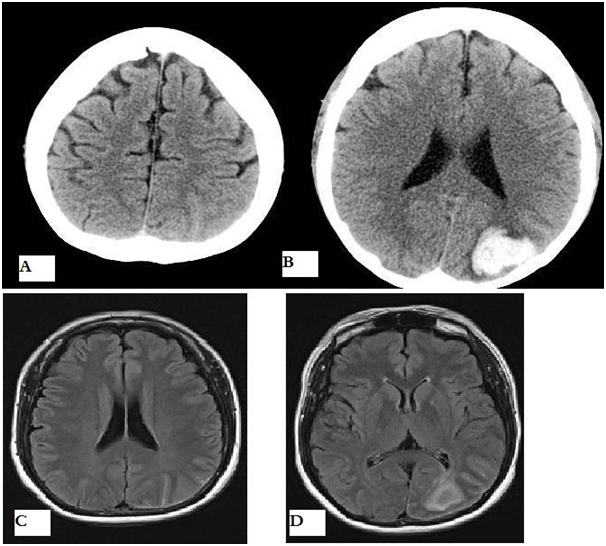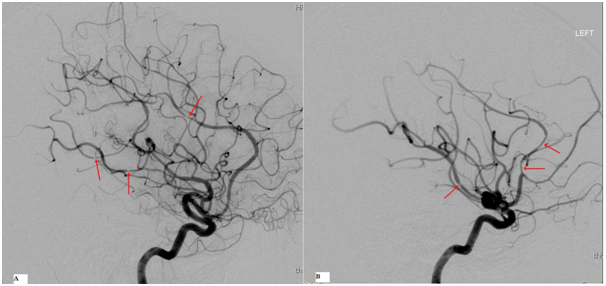Journal of
eISSN: 2373-6410


Case Report Volume 2 Issue 4
1Neurovascular Interventionist, Medina neurological program, Saudi Arabia
2Professor of neurology, director of vascular neurology program, university of alberta hospital, Canada
Correspondence: Bassam Alotaibi, Neurovascular Interventionist, Medina neurological program, medina, Saudi Arabia
Received: June 12, 2015 | Published: July 20, 2015
Citation: Alotaibi B, Shuaib A. Cerebral vasospasm associated with clarithromycin-ergotamine combination. J Neurol Stroke. 2015;2(4):96-97. DOI: 10.15406/jnsk.2015.02.00062
A 55 years old migraineur lady, on ergotamine-caffeine preparation for 8 years, presented with cortical subarachnoid hemorrhage (cSAH), intracerebral Hemorrhage (ICH) and cerebral vasospasm within 3 days of starting clarithromycin for upper respiratory tract infection. In this case report we discuss her neuro-imaging, the pathophysiology and the pharmacokinetics-pharmacodynamics behind this neurovascular event, as well as the serious complications of ergotamine-clarithromycin combination. The aim of this case report is to highlight the importance of taking a meticulous drug history before introducing a new medication.
Keywords:Clarithromycin, Ergotism, Cerebral vasospasm, Hemorrhage
Cafergot is a widely used migraine abortive medication. It is a preparation containing ergotamine tartrate 1mg and caffeine 100 mg. Ergotism is one of rare serious side effects of ergot-based drugs such as ergotamine. Ergotism is defined as an intense arterial vasoconstriction, producing signs and symptoms of peripheral vascular ischemia such as numbness, tingling and pain in the extremities, cyanosis, absence of pulse, and if progressed untreated, gangrene may result. Furthermore ergotism can also involve signs and symptoms of vascular ischemia of other tissues such as renal or cerebral vasospasm.1 The estimated incidence of ergotism in patients using ergot alkaloids is low, up to 0.002%.1-3
Ergotism results from either a chronic intoxication with ergot alkaloid or by an overdose. In few reported cases over the last 40 years, a concomitant use of an ergot alkaloid with cytochrome P450 3A4 inhibitors (like macrolide antibiotics), results in reversible ergotism with serious complications.2-16
We report an extremely rare example of ergotism with cerebral vasospasm caused by coadministration of clarithromycin, a potent P450 3A4 inhibitor, with a long term used cafergot for migraine with aura. We discuss the pathophysiology and the pharmacokinetics behind the neuro-imaging findings.
A 55 years old Asian female with long standing well managed migraine with aura since 2004 was on treatment with Cafergot (ergotamine tartrate 1mg/ caffeine 100mg). Her usual migraine consisted of a severe headache, approximately four times a month, localized at inter-ocular frontal and spread all the way through the cranium to the back of the head. This headache was preceded by shoulder pain and vague holocephalic throbbing head discomfort. The usual migraine headaches would last few hours and responded significantly to Cafergot. After a week of productive cough with no fever, she was started on antibiotic (clarithromycin) by her primary health care physician. Shortly after starting the clarithromycin, she started to have a new form of headache centered over the vertex. It was severe, associated occasionally with nausea but no vomiting. Initially the headache lasted for 30 minutes and subsided with 2 tablets of Cafergot. The headache repeated the second day and again subsided with Cafergot. Both the first and the second time, there was no associated change in her vision and there was no preceding aura as usual. She went to a local hospital where a CT of the brain showed a localized left occipital cortical subarachnoid hemorrhage (Figure 1.A). This subtle finding was missed in the initial assessment, thus, the patient was reassured and sent home.

Figure 1 1A First non contrast CT shows left localized occipital cSAH. 1.B: Follow up NCCT shows centered left occipital ICH. 1.C & 1.D: FLAIR image done 3 days after initial CT, shows localized left temporo-occipital cSAH. In D, an area of vasogenic edema surrounding the hematoma.
Four days later the headache came back again. It was severe, could not be controlled by the Cafergot, and associated with right-sided loss of vision. A day later she went to the Hospital where CT scan of the brain was repeated and showed an intra-parenchymal hematoma, in the left occipital lobe (Figure 1.B). On examination, she was hemodynamically stable and fully conscious, and her examination revealed only a right hemianopsia. The patient was admitted for further investigations. The Cafergot was discontinued and kept on her antibiotic for the 7 day course. MRI and MRA demonstrated a left occipital intra-parenchymal hemorrhage. FLAIR images, showed the left temporo-occipital convexity subarachnoid hemorrhage, more conspicuous (Figure 1. C & 1.D). MRA showed no underlying vascular malformation. MRV showed normal superficial and deep cerebral venous system. A digital subtraction cerebral angiography revealed short segments of mild to moderate vasospasm in various medium sized arteries (pericallosal arteries in both sides, temporo-occipital and posterior parietal branches of right MCA). There was significant slow flow in the parietal and temporo-occipital branches of the right MCA but not in the left (Figure 2).

Figure 2 DSA done 6 days after new symptoms onset and 4 days after stopping ergotamine. Lateral projection of A, right ICA and B, left ICA injections show multiple short segments mild to moderate vasospasm (red arrows).
Detailed clinical and pharmacological history revealed no evidence suggestive of vasculitis disorder and no history of smoking or drug abuse. She underwent a comprehensive vasculitis screen, which was unremarkable.
Ergotamine, an ergot alkaloid, is a substrate of CYP3A4 with vasoconstrictor effect. Ergotamine is used widely in the management of migraine. The pathophysiology of ergotamine-induced vasospasm involves arterial and venous effects by alpha-adrenergic agonist activity and prostaglandin action, as well as calcium and serotonin effects.4,5,18 It has a very low oral bioavailability of less than 10 % due to extensive presystemic metabolism by enterocyte's and hepatocyte’s cytochrome P450 isoenzyme 3A4 in the small intestine and liver, respectively.5,18 Its half-life ranges between 3 and 4 hours. Caffeine enhances the water solubility of ergotamine in the alimentary tract, and increases its absorption in the small intestine.5 Medications interfering with the metabolism of ergotamine can cause a toxic raise in its serum level with the potential for serious complications. Of these medications, macrolides such as clarithromycin, are potent cytochrome P450 3A4 inhibitors.5,18
Most of the reported cases published in English and French literature, have severe occlusive peripheral vasospasm with limb ischemia, and in some cases gangrene.2-8,10-13 Other cases such as optic, carotid including facial and lingual ischemia, coronary, renal, and mesenteric arteries involvement are reported.8,9,14-16 The only cerebral ischemia case reported was the one by Dupuy et al.9 40 years ago.
In our case, the patient presented with ICH, cSAH and mild to moderate short segments vasospasm. The vasospasm was distant from the localized cSAH and ICH. In cases of cryptogenic vasospasm, usually described as reversible cerebral vasospasm (RCVS), estimated incidence of intracranial hemorrhage can approach 34 %. In a prospective analysis of 89 consecutive patients with RCVS, ICH (16%) and cSAH (30%)19 were reported. The exact mechanism of bleeding with vasospasm remains unknown.
The prognosis of ergotism in most of published cases was good. Withdrawal of ergotamine is sufficient to treat some cases. In some other severe cases, pharmacologic interventions with agents such as nitroprusside, prazosin, thymoxamine hydrochloride, IV streptokinase, calcium channel blockers, intra-arterial infusion of prostaglandin E1, IV heparin, nitroglycerin, or intra-arterial nifedipine might be required to improve the circulation.4,6
Under the constellation of reversible cerebral vasospasm, many ideologies have been identified. A careful pharmacological history is mandatory to avoid or to identify serious drug-drug interactions.
None.
None.

©2015 Alotaibi, et al. This is an open access article distributed under the terms of the, which permits unrestricted use, distribution, and build upon your work non-commercially.